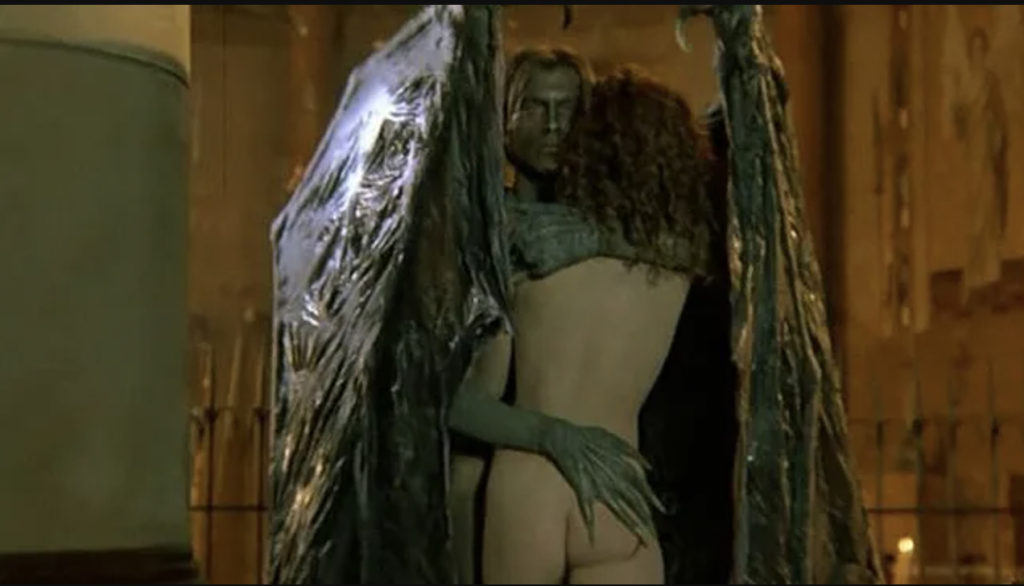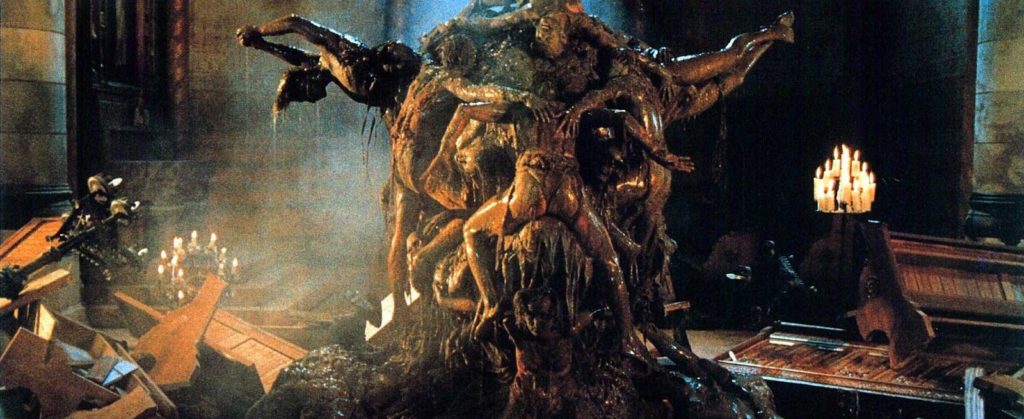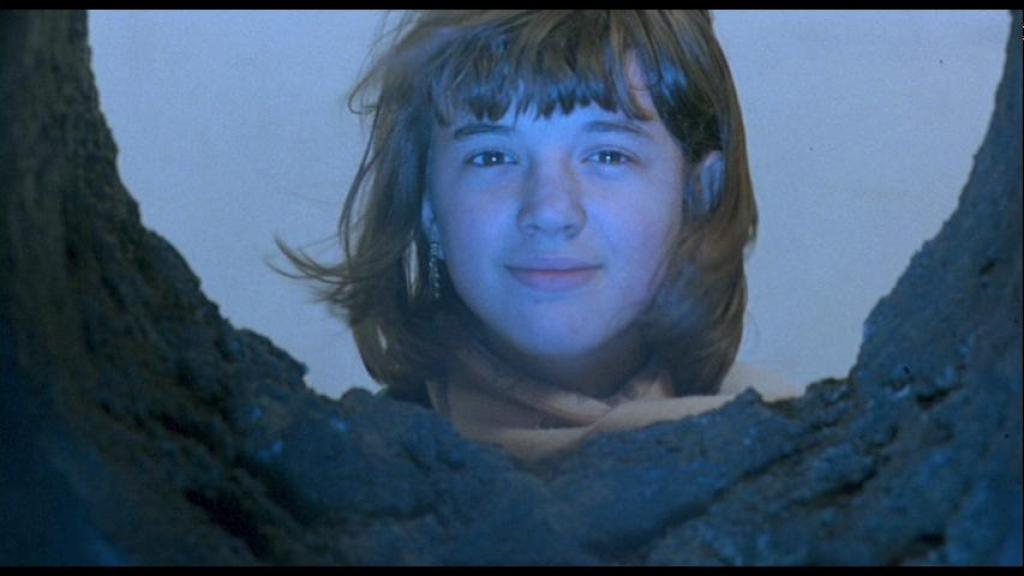When Italian horror comes to mind, it’s the unholy trifecta of Dario Argento, Lucio Fulci, and Mario and Lamberto Bava that dominate the discussion. However, Michele Soavi is another essential – albeit underrated – Italian horror savant from the ‘80s and ‘90s who cut his teeth as Argento and Fulci’s apprentice, before ascending to become their peer through formative films like StageFright and Dellamorte Dellamore (aka Cemetery Man). Soavi has a flair and appreciation for immersive and complex camera visuals, intimidating antagonists, and gruesome gore, all of which are on display in the director’s most polarizing film, The Church, which now celebrates its 35th anniversary.
This cinematic achievement began as Demons 3, the third film in Argento and Lamberto Bava’s popular supernatural horror series. However, the horror sequel soon pivoted into an original project early on in its production after Bava walked and Soavi took over and completely rewrote the script. In doing so, Demons 3 was banished to hell and The Church was born. 35 years after its debut, The Church is still a scrappy, underrated piece of Italian horror cinema, but one that audiences have only grown more fond of in recent years.
The Church beautifully adheres to the whole “strangers trapped in a haunted church subgenre” and it’s much in the same vein as Prince of Darkness, From Beyond, Dark Waters, or Lucio Fulci’s Demonia. These movies often have conflicted people from diverse backgrounds and belief systems who are forced to grapple with faith and the meaning of life, which usually culminates in a grueling fight for survival. The Church is no different and while it subscribes to many of Soavi and Argento’s preexisting tropes, it actually feels more akin to a Fulci or Bava picture, despite Argento and Soavi’s extensive rewrite of Franco Ferrini and Bava’s screenplay to make it their own (Bava’s original concept was largely set on a grounded airplane). The Church is honestly like Indiana Jones meets Evil Dead, with a touch of The Exorcist thrown in for good measure. There’s also lots of business with Satanic goo and ancient artifacts, which seem to be staples for these types of gothic, religious demon stories.
The titular church itself is utterly gorgeous and really does a lot of the heavy lifting here. The Church was shot at the Matthias Church in Budapest for its exteriors and the St. Elizabeth of the House of Arpad Church and the St. Nicholas Church in Hamburg for the interiors. Curiously, Argento has indicated that the production’s hunt for the right church proved to be difficult since nobody in Italy, France, Germany, and Switzerland would agree to be a filming location due to The Church’s intense subject matter. It’s often cliché to claim that a location is one of a film’s most important characters, but it’s absolutely true in the case of The Church and a testament to the movie’s atmosphere…as well as a reflection of its cast of one-note caricatures. The Church leans on the running theme of young women who get victimized by manipulative men, not all of whom are possessed by demonic spirits, but are still inherently wicked. This is hardly new territory for the genre, but it’s still fitting for the film’s grim subject matter.

The Church kicks off to a genuinely wild and unexpected opening that attempts to give some context to the demon-conjuring madness that follows with a prologue that’s set in the past and looks at Teutonic Knights and witch massacres. It’s highly reminiscent of Conan the Barbarian and feels like the type of approach that Sam Raimi would take with one of his Evil Dead movies, particularly Army of Darkness, where horror explicitly co-exists with revolutionary history. It’s a distinct introduction that immediately begins The Church on a memorable note — albeit a confusing one — that sets it apart from the rest of Soavi and Argento’s filmography. It’s a striking start that’s hard for the rest of the movie to follow through on.
The Church’s prelude is crucial to understanding the rest of the film, but it’s easy to imagine an ambitious sequence of this nature getting completely edited out of the movie or instead turned into exposition that’s revealed deeper into the movie. If nothing else, The Church deserves respect for retaining such an out there period piece introduction that runs for over ten minutes. The film is better off for taking this approach to its storytelling than the more conventional angle that one would find in most other horror films. Oh, and there are ducks! When was the last time that you saw a horror film that had ducks in it?
Once The Church leaves the 12th century, the movie features a church sermon where a Bible passage about outcasts who resist Satan’s temptations gets recited. This becomes a guiding light for the various characters who get embroiled in this demonic situation. Later on, “The world is the devil’s,” a famous Latin quotation, is also casually recited. This becomes The Church’s creed and it speaks to how dark forces are everywhere and can appear when people least expect it. For instance, there’s beautiful symmetry between the shots of the cross that end The Church’s prologue and the ones that conclude the film, which signify that this curse is still active and that greater dangers are to come. The cycle conceivably begins anew. The evil is never over and the devil is never gone.
The Church is a horror movie that understandably receives a lot of criticism because it’s light in story and more of a gothic tone poem where you’re meant to get consumed by the moody atmosphere, much like the characters who are stuck in the titular church. Such an approach doesn’t always work, and it’s a risky maneuver to attempt. Audiences will either be on board with The Church or just be perplexed over what’s going on, but those who are into it will truly love what it’s going for. The film’s final half-hour where all hell – literally – breaks loose and The Church really gets to the good stuff. There are exceptional practical effects and monster work by Danilo Bollettini, Renato Agostini, Massimo Cristofanelli, and Sergio Stivaletti, all of whom had previously worked with the likes of Soavi, Argento, and Lamberto Bava. The rogue gargoyle angel and facehugger-esque creature that jumps out of a holy water stoup are incredibly memorable, as are the visuals of banging a church bell with a severed priest’s head or the young woman who rips off her grotesquely aged face in a mirror. A vicious jackhammer death is also quite original.

These compelling effects convey demonic entities in truly creative and terrifying ways that feel like something from a John Carpenter or David Cronenberg picture rather than an Italian horror movie. The writhing clay monument that emerges during the finale functions as if it’s something from out of Society. The Church’s cinematography by Renato Tafuri, another frequent Soavi and Argento collaborator, is really on point here. Massacres play out through silhouette and through the cross-shaped vantage point of Teutonic knights. There’s such a curious, exploratory camera that freely travels through the movie, as if it’s a rogue force of nature that’s as desperate for answers as the characters who are at the center of the movie.
The Church is a mixed bag that’s akin to a collection plate that’s full of junk from the conjugation’s pockets. It’s arguably the worst of Soavi’s features and it can’t compare to StageFright or Dellamorte Dellamore, but to be fair, those are true genre classics. The Church is still an interesting ride and mostly successful at what it does. It’s worth noting that production on The Church proved to be equally frustrating for Soavi. His dissatisfaction over the final product became the beginning of the end for Soavi’s collaborations and working relationship with Argento, which would properly dissolve following 1991’s The Sect (aka The Devil’s Daughter). Soavi headed down his own path, which is ultimately what pushed him into obscurity and gradually turned him into a less iconic horror director who retreated to TV movies. The Church isn’t void of its creepy charms, but the rift that it precipitated between Soavi and Argento is its worst crime. One wonders what the two could have brought out in each other through future horror collaborations, even if they happened to be further attempts to resurrect the Demons franchise.
The Church struggles to reinvent its subgenre, but its gonzo narrative and satisfying gore make it a decent relic of the late ‘80s that’s still worthy of unearthing 35 years later for a late-night horror session. It’s a movie that’s only more fascinating when viewed in the larger context of Soavi and Argento’s careers, as well as the growing number of Satanic gothic chamber plays that followed in the subsequent decades. The Church couldn’t take over the horror world and rejuvenate Soavi’s career, but maybe that’s just proof that the world is, in fact, the devil’s.
‘The Church’ is available to stream for free on Tubi and rent on Apple TV+

The post Michele Soavi’s ‘The Church’ Continues to Evoke Evil & Rip Faces After 35 Years appeared first on Bloody Disgusting!.